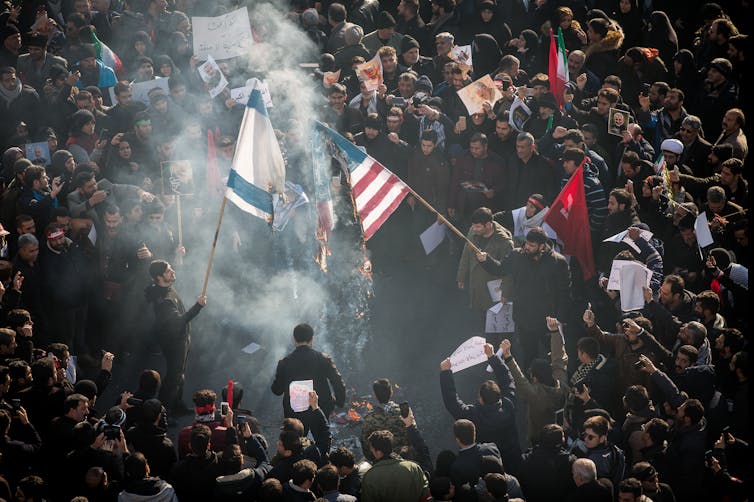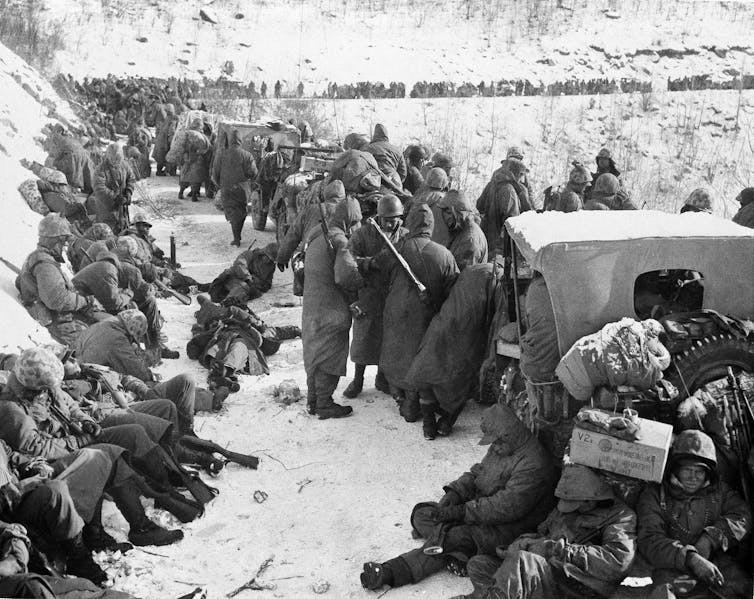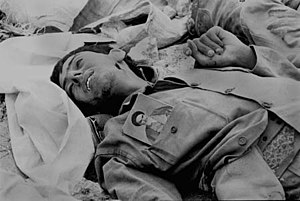Bear F. Braumoeller, The Ohio State University
 |
| Mourners at the funeral for Maj. Gen. Qassem Soleimani burn Israeli and U.S. flags. Hamid Vakili/NurPhoto via Getty Images |
Trump administration officials’ confidence that the present conflict with Iran can be managed could be dangerously misplaced.
Since a drone strike at Baghdad airport that killed a top Iranian general, Iranians have been protesting in the streets in massive numbers, and their country has pulled out of the 2015 deal limiting its development of nuclear weapons.
Iraq’s prime minister and Parliament have moved to kick the U.S. military out of their country – troops who have in the meantime stopped fighting the Islamic State group and are instead focusing on keeping themselves safe.
Iran has vowed “harsh revenge” for the Jan. 3 killing of Iranian Maj. Gen. Qassem Soleimani.
Policymakers in the Trump administration have said they believe that the use of force will prompt Iran to back down, or at least that any escalation will be manageable. My research into how conflicts begin and how deadly they get shows that while most wars don’t escalate very far, those that do can easily become catastrophic.
But while most wars remain small, my own analysis of trends in warfare concludes that the threat of wars with large numbers of casualties has not decreased. It’s dangerous to assume that Iran will not escalate the crisis further, much less that the U.S. could limit any violence that might ensue.
Big wars are more common than people think
| The Chaco War between Bolivia and Paraguay in the 1930's cost more than 100,000 killed (Today's History.org) |
World War I and World War II are not even in the top three deadliest international wars in the past two centuries, based on the number of battle deaths as compared with the combined populations of the warring nations.
Two South American wars, the Paraguayan War of the late 1860s and the Chaco War from the mid-1930s, are the deadliest on record.
The Paraguayan War, little known outside of military history circles, may have cost Paraguay half – or more – of its total prewar population.
The Iran-Iraq War of the 1980s, the most recent of the top five, was the third when ranked by death rates.
Only then come the two world wars.
Not every conflict becomes a massive war, of course.
It is possible that Iran could be deterred by the threat of large-scale American retaliation, as Secretary of State Mike Pompeo argued on Jan. 5.
But it is dangerous to assume there won’t be a war, even if it’s true that neither Iran nor the U.S. wants one.
Escalation is very hard to predict
In late summer 1914, as World War I began, German Kaiser Wilhelm II famously promised his troops that they would be “home before the leaves have fallen from the trees.”
In World War II, even after Hitler had invaded Poland in 1939, American diplomats believed that economic pressure alone would suffice to bring Nazi Germany to its knees. In both cases, years of bloody warfare followed.
 |
| U.S. Marines in northern Korea are stalled by a Chinese counterattack on Dec. 14, 1950. AP Photo |
What I’ve found is that escalation typically results from chance occurrences that simply can’t be foreseen.
Virtually no one predicted the fall of France to the Nazis in the summer of 1940.
No one could have known that President Harry Truman would decide, against the advice of his National Security Council, to send U.S. forces across the 38th parallel during the Korean War, and few observers anticipated that doing so would bring China into the conflict.
Major wars are “black swans” – rare but incredibly consequential events that cannot be predicted.
Chance plays a huge role in war
The role of chance events in warfare can be dramatic.
Hitler’s successful invasion of France transformed what had been a problem of regional containment into a years-long global conflict with more than 16 million people killed in battle. A driver’s wrong turn in Sarajevo in 1914 turned what would have been a botched assassination attempt into World War I.
Chance works both ways, of course: The Union of Concerned Scientists has documented a hair-raising array of nuclear near-misses that mostly caused no harm but could have resulted in millions of deaths.
War can be volatile – while most remain small, big ones can come out of almost nowhere. I see in this imbalance a similarity to a concept called the “80/20” rule, in which 80% of outcomes come from 20% of cases: About 80% of world income, for example, is held by 20% of the global population.
In warfare, lethality of international conflict is considerably more concentrated. The data I analyzed shows that over the past 200 years, the deadliest 20% of wars are responsible for 98% of all battle deaths.
No one wants very large wars, and most wars do end up being relatively small. But the potential for chance events to blow up into massive conflicts means nobody really knows, and nobody can predict, when the next really big one will come along.
[ You’re smart and curious about the world. So are The Conversation’s authors and editors. You can get our highlights each weekend. ]
Bear F. Braumoeller, Baranov and Timashev Chair in Data Analytics and Professor of Political Science, The Ohio State University
This article is republished from The Conversation under a Creative Commons license. Read the original article.
